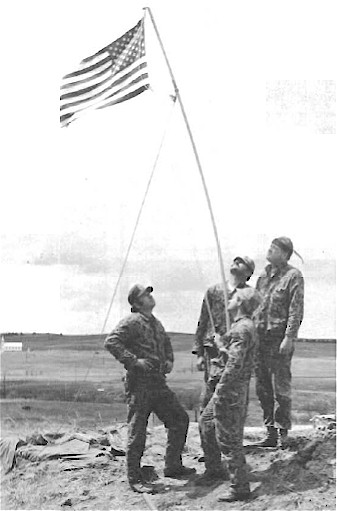Incident at Wounded Knee
The incident began in February 1973, and represented the longest civil disorder in the history of the Marshals Service.
The town of Wounded Knee, South Dakota was seized on February 27, 1973, by followers of the American Indian Movement (AIM), who staged a 71-day occupation of the area. In response to the incident, Marshals Service volunteers stepped forward from all ranks of service to assist in a resolution. U.S. Marshals, Chief Deputies, Deputies, and support personnel alike were ready to make the sacrifices required to join the historic operation.

At its conclusion, U.S. Marshal Lloyd Grimm (District of Nebraska) would lie seriously wounded, as would an FBI agent. Two Indians would also unfortunately be killed. Exposure to personal danger, extreme weather conditions, prolonged hours of duty, and absence from home were just a few of the many frustrations people of the Marshals Service faced at Wounded Knee.
On May 8, 1973, the confrontation at Wounded Knee ended after ten weeks of para-military action and negotiations. On this date, the occupiers of Wounded Knee surrendered their arms and the U. S. Marshals Service took control of the town.
When the Wounded Knee operation was initiated it came within the purview of the Special Operations Group (SOG), which had been formed only two years before. Special Operations Group is a highly trained, highly motivated group of volunteers who can provide a self-sustained mobile quick reaction force capable of a federal response to a civil disturbance or riot situation where military intervention is inappropriate. Since Wounded Knee, Special Operations Group has responded to numerous calls of the Attorney General and the Federal Court.
For two and a half months in early 1973, hundreds of stories were filed by the networks, wire services, and print media bringing the Wounded Knee situation to the American public. For the U.S. Marshals Service there was definitely a sharpening of skills and experience in command, control, administration, logistics and operations, and it is in these areas that the Service gained its greatest benefits. Ingenuity, self sacrifice and heroic actions were commonplace during those days in 1973.
Typical of these were the actions of Inspector Wayne McMurtray, Southern District of Mississippi, who was one of two Deputy Commanders of the Special Operations Group and participated in many Special Operations Group operations. However, at the time of this Wounded Knee operation he had only participated in a few previous Special Operations Group missions. From the beginning of the Wounded Knee operation, McMurtray was assigned as the Specialty Unit Commander with the responsibility of suppressing any heavy fire on the Marshals roadblocks that surrounded the armed American Indian Movement (AIM) dissidents occupying the unhappy hamlet.
During the first day of this operation at the roadblocks, there were six FBI agents being attacked and pinned down. McMurtray and Deputy Jim Propotnick (later became Chief Deputy U.S. Marshal, District of Hawaii) were ordered to repel the attack with an armored personnel carrier. McMurtray and Propotnick arrived at the roadblock just as a group of the dissidents were about to overrun it. However, with Propotnick driving and McMurtray on top of the armored personnel carrier firing, they were able to successfully repel the attack.
During another instance on a cold, windy afternoon in late February, one of the Marshals Service roadblocks was pinned down by heavy gun fire from within the hamlet. McMurtray moved up into a forward position and attempted to suppress the fire from an exposed hillside position. When the dissidents realized they were receiving accurate fire from McMurtray's position, they shifted their fire and pinned Wayne down. He then radioed the Command Post for more ammunition and fire support and shortly thereafter was surprised to see Associate Director William Hall supporting him on his left with effective fire from an anti-sniper weapon. With the additional assistance of Jesse Grider from the Headquarters staff, who was handling the ammunition, they soon gained fire superiority.
Another time McMurtray headed to a U.S. Marshals Service roadblock that was pinned down by sniper fire of undetermined position. Wayne moved to an exposed position to draw fire and determine the sniper's location, which was quickly accomplished. During this exchange of fire, shell fragments were thrown into Wayne's face, causing heavy bleeding. Wayne's heroic actions exposed the sniper's position and after radioing for a helicopter, the snipers were flushed with gas grenade 'launchers and automatic rifle fire.
McMurtray also remembers the cold, long, and dark nights at Wounded Knee when the dissidents used an automobile with dual spotlights (nicknamed by our people as "Spotlight") to harass U. S. Marshals' roadblocks. After receiving permission from the Special Operations Group Commander to put a stop to this harassment, McMurtray moved out by night to a forward position near a road which was frequented by "Spotlight". By ingenious action he was able to disable the spotlights, and the automobile was immediately abandoned by the dissidents.
Wayne's actions were typical of the heroism and imagination shown by U.S. Marshals Service personnel at Wounded Knee time and time again.

